While addressing a rally in Haldia on 7 February, Prime Minister Narendra Modi compared the misrule of the current Trinamool Congress government led by Mamata Banerjee as “a rebirth of the misrule of the Left Front government in the state”. This is ironic, given how much the Bharatiya Janata Party in West Bengal has appropriated the symbols and images of the Left in its campaign strategy to attract voters who are dissatisfied with the Mamata government.
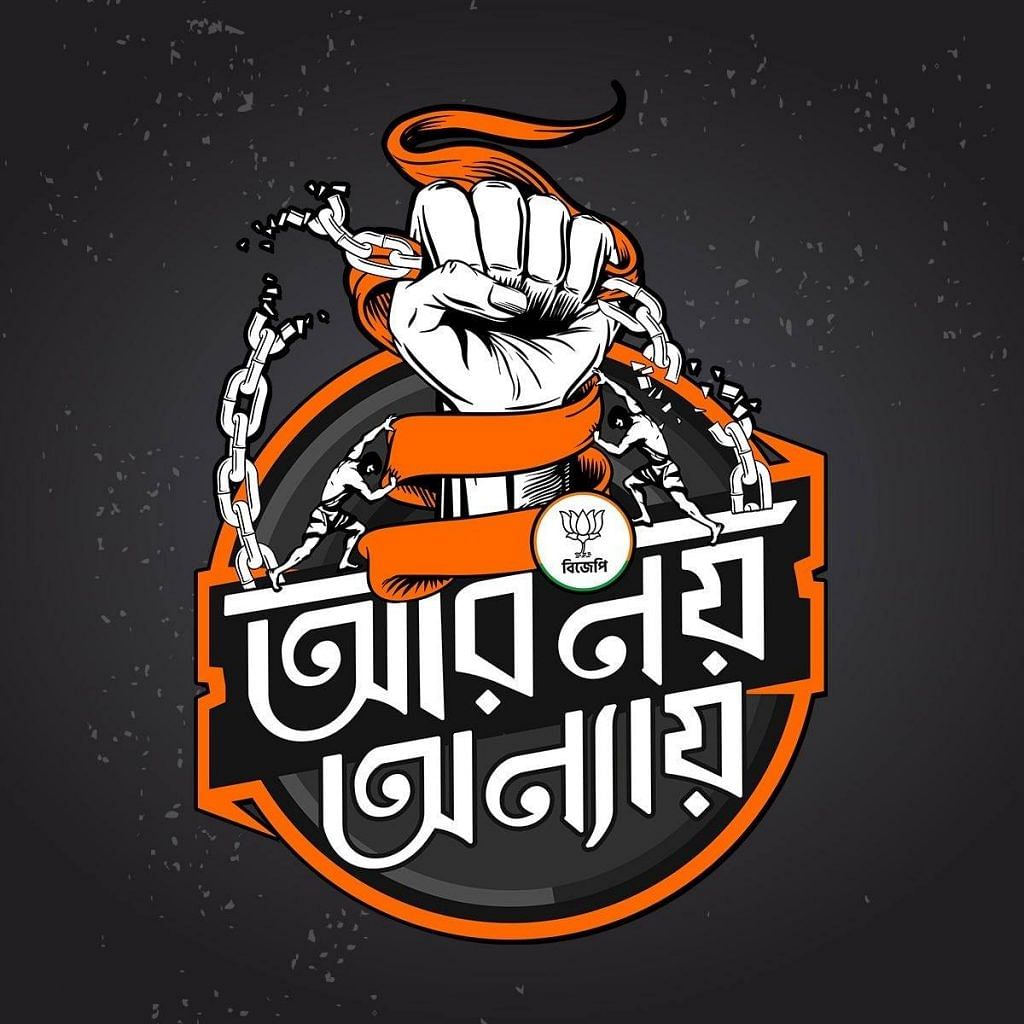
Our DigiCampAsia study shows that the Bharatiya Janata Party (BJP), in its official digital campaign, has been frequently invoking popular Leftist images, albeit with a pinch of saffronisation. Raised fists, images of Leftist processions, Soviet-era and agitprop art (agitational propaganda art) have all been added to its kitty, which until now have been the Left’s prized artistic possession to mobilise political support.
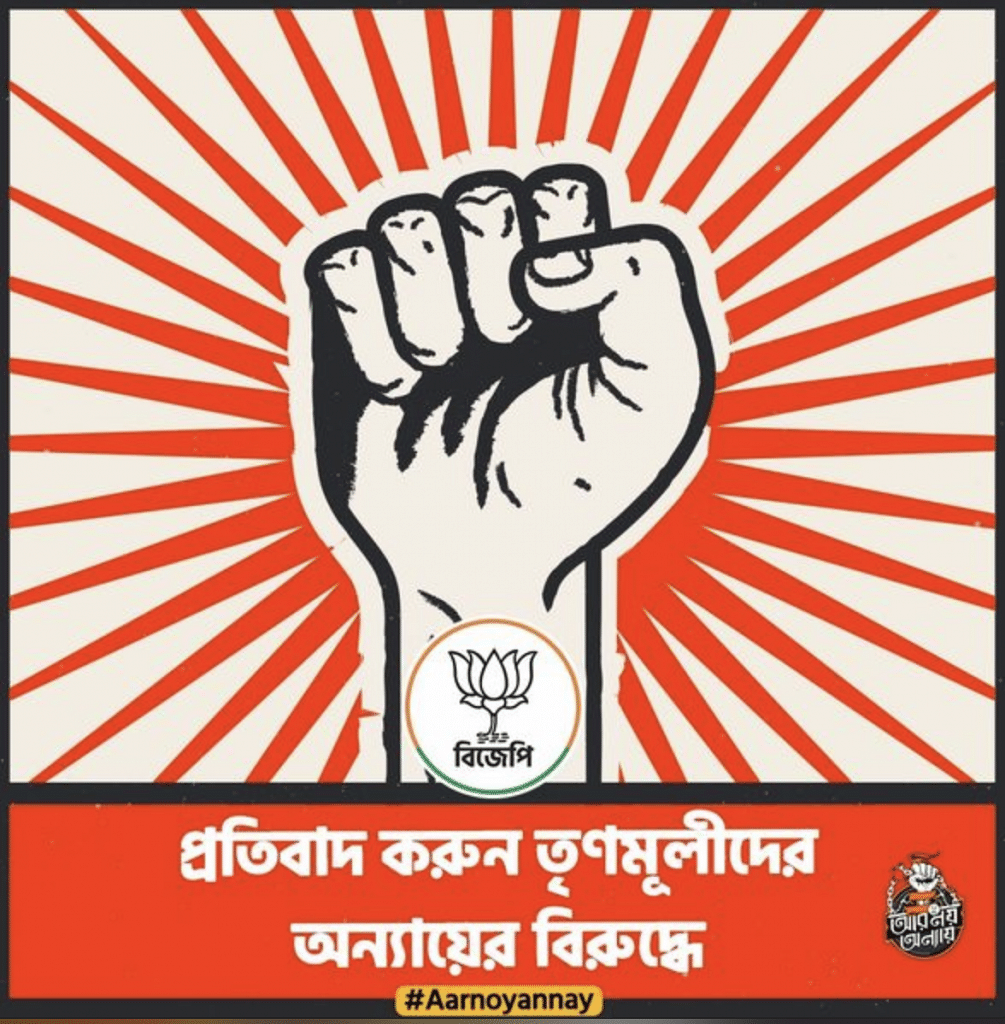
‘Aar Noi Onnay’ translated as ‘No more injustice’, which is BJP’s official slogan for the upcoming assembly election, has interestingly used the image of hands breaking free from shackles with two men (in typical Leftist representation of the working-class body) supporting it (Image 1). Its official Facebook page ‘BJP West Bengal’ is also constantly circulating images that until now have been associated with Left-wing politics in West Bengal (Images 2, 3, and 4).
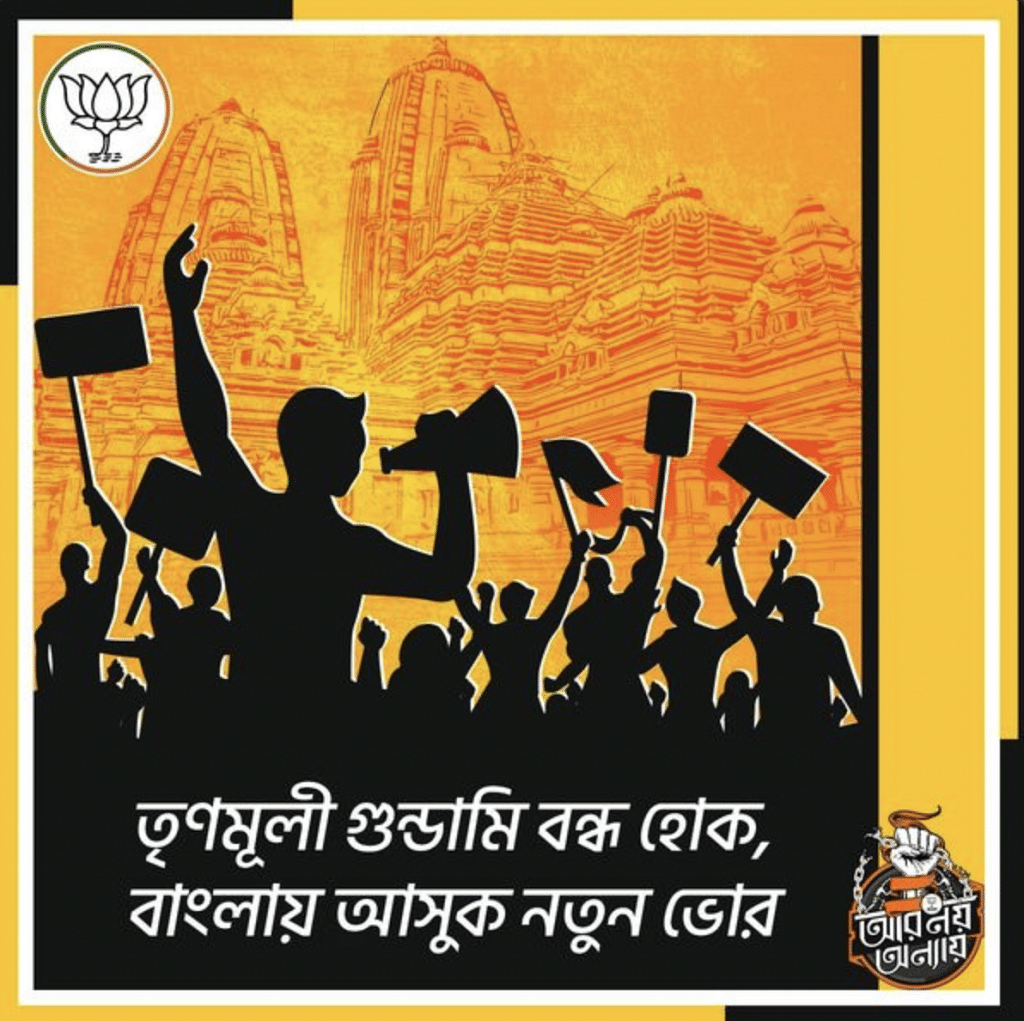
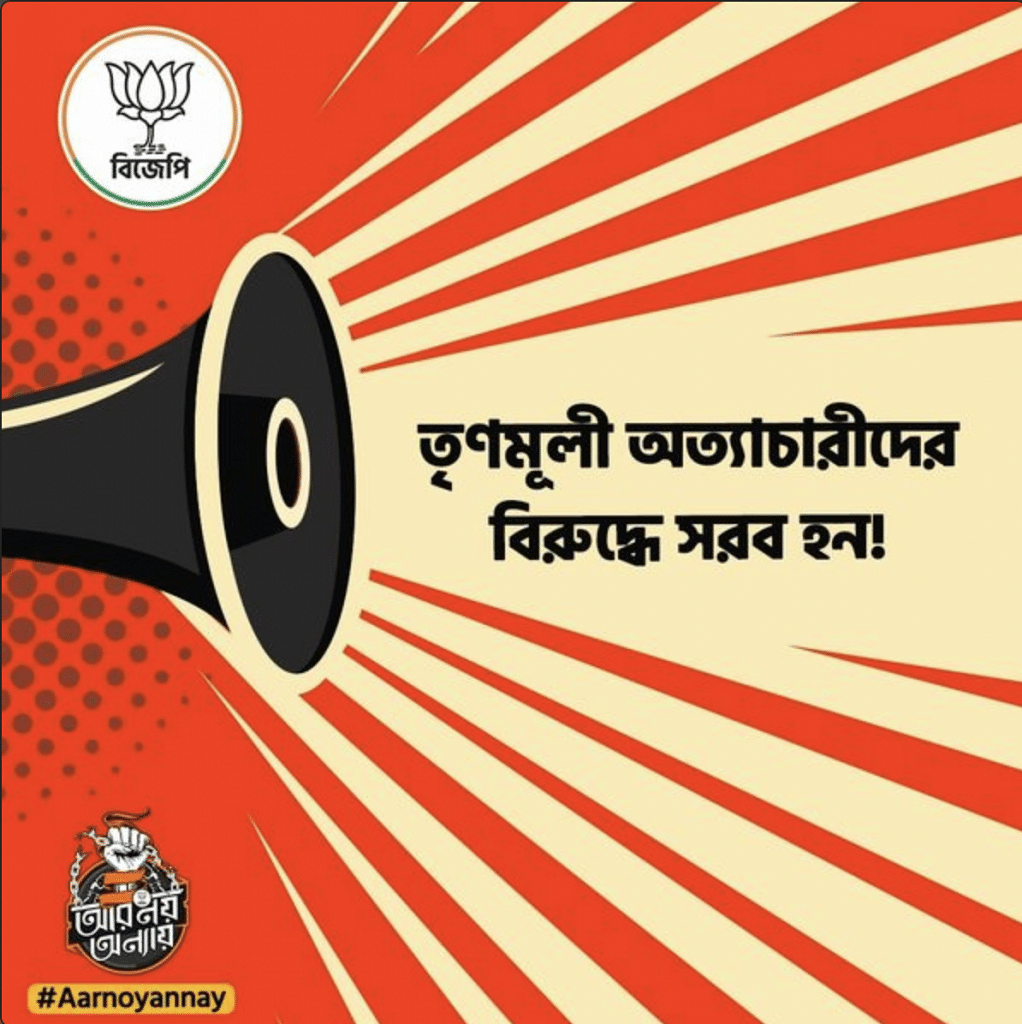
The question is why has the BJP adopted a strategy that is associated with its ideological arch rival, the Left. An easy answer could be that it wants to attract the aggrieved Left voter running high on anti-incumbency sentiments. But that does not capture the entire story. The BJP has other ways to pull Left voters towards itself, and has already put into action an elaborate tactical mechanism on the ground for this purpose. In its booth-level activity, it has done its homework and is playing by its tested knowledge of winning people over by placing itself as the sole alternative to the current government. This was the same strategy adopted by the BJP during the 2019 Lok Sabha election that led to it winning 18 out of 42 Lok Sabha seats in West Bengal. A sharp decline of the Left Front vote percentage from 29.7 per cent in 2014 to 7.5 per cent in 2019 was proportional to the BJP’s increase in vote percentage from 17.1 per cent in 2014 to 40.6 per cent in 2019.
Also read: Posters, boat rides & tea stalls — how BJP plans to use Durga Puja to win over Bengal
Tea-stalls, the site of the political
A more appropriate way of looking into the BJP’s adoption of popular Left symbols would be to trace Bengal’s own history, and how its politics is related to protest art. Bengal’s unique history since Independence has seen the Leftist imagination dominating the public sphere. The public sphere is famously theorised by the German philosopher Jurgen Habermas as the place where private individuals meet in a discursive space to discuss, debate, and form public opinion. Politics in this sense is mediated through rational debates in an enlightened fashion.
Public sphere in Bengal comprise ‘cha-er dokan’ (tea stalls) and ‘adda’, a la Nobel Laureate Amartya Sen, and these spaces play a significant role in the spatial landscape of cities and villages throughout the state. In cities, they occupy the narrow lanes, between hedges or on the sidewalks of the city roads. In villages, tea stalls axiomatically come to occupy a central point where people meet after a day’s work. In many of these shops, one can find hand-painted iconography of political parties, such as the hammer, sickle and star of Communists with slogans. Art and politics have historically webbed an intricate relation in which the debates and discussions are done with a particular background or foreground coloured with a definite aesthetic. These spaces are now reproduced online, and integrated into campaign strategies of political parties.
Also read: ‘Will suffer Mamata misrule, not BJP’ — Bengal intellectuals don’t want another ‘poriborton’
TMC — More Left than Left?
It is also important to understand the Trinamool Congress (TMC)’s role in dealing with this typical feature of Bengal’s politics. A brief recapitulation of Bengal’s recent past and the TMC’s ‘Poriborton’, or assumption of change, will help us contextualise the BJP’s digital campaign.
The TMC, despite its apparent Centrist position, fashioned itself as the new messiah of the Left in the days of fiery peasant agitation in Singur and Nandigram. It drove to power by successfully asserting that the ‘Left was not left enough’, and that the Left had become a turncoat of capitalists like the Tatas and Salims. The TMC’s populist nature comfortably appropriated the Leftist sensibility to such an extent that many Left intellectuals sided with them. Popular Bengali Indian People’s Theatre Association (IPTA) songs, such as ‘Hei Samhalo Dhaan Ho’ from the Tebhaga movement, were used in public meetings and processions. Tea stalls became an active site of contestation where slowly the change of power in the state could be felt in the flow of arguments one heard.
Ever since the TMC came to power, it re-asserted what the Left did to maintain its political hegemony. The Left had created newspaper stands in addition to tea stalls where Ganashakti — the official daily newspaper of the Communist Party of India (Marxist) or CPI(M) — used to be affixed for the public to read. The TMC imitated this and created its stands where its own official daily Jago Bangla could be seen.
While the nature of debates changed as new entrants entered these arenas, their basic ideological foundation and importance in Bengal society remained intact. It is important to note that the TMC has now taken a more Bengali regionalist position. However, one would not be surprised if IPTA songs are still occasionally played, or a poem of the much-beloved Leftist poet Sukanta Bhattacharya is recited to portray the BJP as an ‘evil outsider’.
Also read: Why it’s so easy for Modi to appropriate Tagore — or anyone
BJP as a band of outsiders
The BJP in Bengal is undergoing an existential quest to usurp power after having been branded the ‘band of outsiders’ by TMC’s campaign team led by popular poll strategist Prashant Kishor. In political campaigns, creating and presenting an image to voters is more important than possessing one. Because of its image as outsiders, the BJP in Bengal faces a historical emptiness. Though Bengali ‘bhadralok’ society is rife with all elements of communal tendencies, and the BJP is building strongly on these fault lines, the ‘outsider’ label has not yet been undone. The party does not have historical characters to cash in on from Bengal’s intellectual and cultural universe. Mamata Banerjee, and even a large section of civil society, has taken notice of this fact and occasionally attacked the BJP on the grounds that it is a party of ragged individuals alien to Bengal.
Thus, the BJP is making desperate attempts to portray itself as situated and rooted in Bengali culture. How then would one understand Dilip Ghosh, BJP state President, using Nabarun Bhattacharya’s poem about the Naxalite martyrs of Barasat in the scenario of BJP members being allegedly killed by TMC goons? In the same post, Ghosh quoted lines from Latin American revolutionary Otto Rene Castillo’s poem, ‘Apolitical Intellectuals’, to take a dig at the ‘decadent’ public intellectuals of Bengal. These kinds of posts are placed deliberately on Facebook to demonstrate that the BJP is not aloof from the world of literature and culture (Image 5), and that the BJP can also articulate itself through the arts to assert its political positions. The current digital media campaign should, thus, be seen in this light.
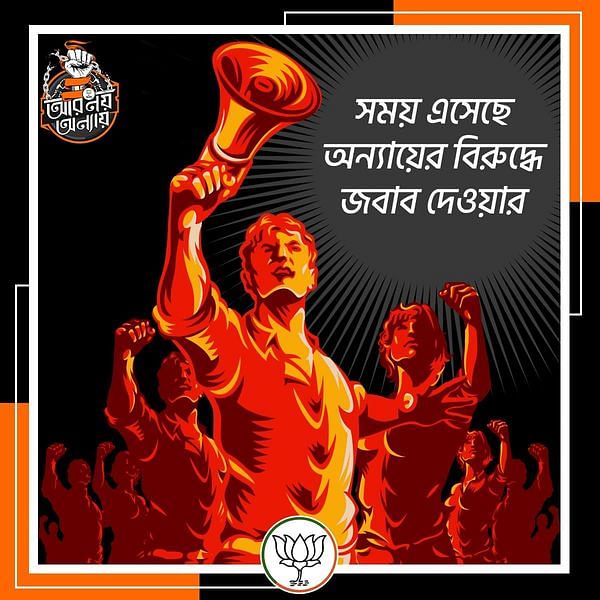
Source: BJP West Bengal Facebook Page
Social media as a public sphere
It is debatable whether social media has introduced a new public sphere in Bengal politics. There is some truth in this assertion since it has become a space where private individuals meet to express and share their political opinions. But what is more important is situating the BJP’s digital campaign in light of what has been earlier established, in the case of tea stalls, as a discursive space. Does the BJP think social media can effectively replace this or be a substitute for the tea stall? It is our reading that the BJP is indeed trying to fulfil the ‘historical emptiness’ by suggesting that it cannot be written off as a bunch of philistines who only know how to abuse netizens on social media. The BJP is yet to have the organisational or intellectual potency to clinch a new aesthetic in Bengal’s tea stalls or coffee houses; hence, the party has launched a more composed campaign and appropriated Left symbols to woo the ‘bhadralok’.
There is no doubt that on the ground, and also on social media, it is working on the same game, as it has in the rest of the country, which is to evoke communal passions and rally people on the absurd cry of ‘Hindu khatre me hain’ (‘Hindus are in danger’). But one cannot overlook the fact that a significant part of their official social media campaign is devoted to maintaining a tone of restrained and strategic communication meant to steer public opinion. It has left out personal attacks until now, and is more focused on trying to debunk the performance of the Mamata government through a plethora of social media posts that refer to facts and figures with the caption ‘TMC’s report card’. Most importantly, it is putting all its efforts into permeating the long-held cosmopolitan sensibility of the Bengalis, which has been ingrained and sustained through the Leftist movement. It is responding to what is a received political aesthetic in Bengali culture in order to establish itself as an ‘insider.’ Whether the famed Bengali Leftists are attracted to their rhetoric and are subscribing to their agenda is a separate question.
Debopriya Shome is a Post-Graduate student in the Dept. of International Relations, Jadavpur University. Taberez Ahmed Neyazi @TaberezNeyazi is Assistant Professor of Political Communication and New Media, and Principal Investigator at the Centre for Trusted Internet and Community at the National University of Singapore (NUS). Views are personal.


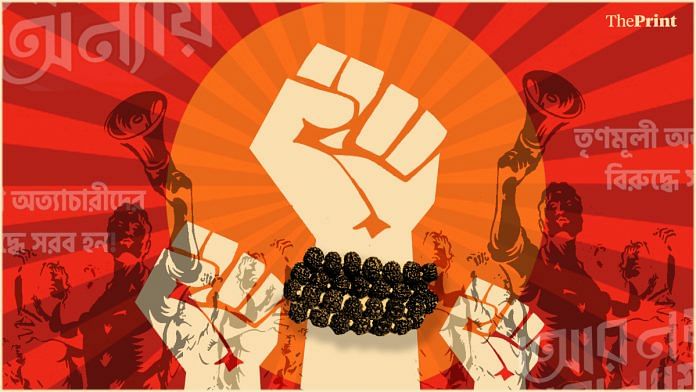

Interesting read, no doubt!
To be completely honest the only reason why left wins on social media is cause of the high quality propaganda when you don’t have an effective ideology you need effective propaganda so BJP is just cashing in on it cause Indians don’t vote for them not cause they think that capitalism doesn’t work some don’t vote for them cause they know nothing about capitalism, courtesy of soviet era propaganda campaign continuing to this day.
More than the threat of china and pakistan it’s the ultra left wing radicals and jihadist who are coordinating that’s a bìgger threat.
THE reason for withdrawal of Chinese forces is the defeat of ultra left wing radicals and jihadist to ensure massacre during 26 Jan and thus create chaos and bloodshed all over INDIA which would have created diversions for china to attack INDIA.
It’s now clear two consequential failures as in anti caa and farmers protest is frustrating and angering chinese and pakistani handlers and a new ferocious attack in the stronghold of West BENGAL can be expected.